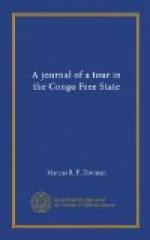Only about twenty Europeans live at Banana and their chief excitement is the arrival of the steamer. Most of them indeed came off to dinner and held a kind of concert in the saloon afterwards. All night long winches and men were creaking, groaning, and shouting, as some of the cargo was put overboard into two large lighters. It was not however, destined for Banana and was transshipped here only to lighten the Leopoldville so that she could pass a certain bar higher up the river. The cargo consisted of coal in the shape of brickets, cement, rice, oil, cloth, clothes, beads, salt and general provisions. As soon as sufficient had been removed, the two lighters were attached one to each side of the ship and we started up the main stream, which here runs between the south or Portuguese bank and a series of islands. All these are covered with dense forest the only living things visible being great black eagles with white wings. On the left bank of the river we pass Malela, a station for collecting bamboos, and soon after Kissange on the opposite side where palm oil is made and shipped. A little higher up, the country opens out and a range of hills becomes visible in the distance, the plain between being covered with coarse grass six or seven feet high, relieved at intervals by solitary palm trees. This is all Portuguese territory, the Congo State here possessing only a narrow strip of land along the northern bank. The course of the river here is very sinuous, winding in and out among the hills, the curves being cut more sharply each day as the water eats into the sand and carries it to be digested in the great stomach of the Atlantic.
In this district both the State and the Portuguese have started large farms for breeding European cattle which thrive here satisfactorily. Higher up a solitary rock overhangs the left bank. This is known as Fetish Rock from the legend that the natives used to throw live people from it into the river as sacrifices. This is possibly true but there is little evidence to show that the natives of the Congo ever sacrificed either living or dead to propitiate anyone or anything.




